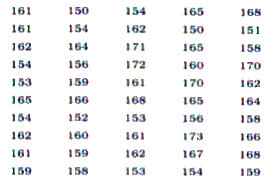Complete Solutions to EXERCISE 14.2 of chapter STATISTICS of Class 9 book with complete answers and questions
| Class 9 | MATHS |
| Chapter | STATISTICS |
| KUMAR PRAKASHAN | EXERCISE 14.2 |
| Number Of Questions | 9 |
| Academic Year | 2023-24 |
The blood groups of 30 students of Class VIII are recorded as follows: A, B, O, O, AB, O, A, O, B, A, O, B, A, O, O, A, AB, O, A, A, O, O, AB, B, A, O, B, A, B, O. Represent this data in the form of a frequency distribution table. Which is the most common, and which is the rarest, blood group among these students ?
View SolutionThe distance (in km) of 40 engineers from their residence to their place of work were found as follows :

Construct a grouped frequency distribution table with class size 5 for the data given above taking the first interval as 0-5 (5 not included). What main features do you observe from this tabular representation ?
View SolutionThe relative humidity (in %) of a certain city for a month of 30 days was as follows:

(i) Construct a grouped frequency distribution table with classes 84-86, 86-88, etc. (ii) Which month or season do you think this data is about ? (iii) What is the range of this data ?
View SolutionThe heights of 50 students, measured to the nearest centimetres, have been found to be as follows:

(i) Represent the data given above by a grouped frequency distribution table, taking the class intervals as 160 - 165,165-170, etc. (ii) What can you conclude about their heights from the table ?
View SolutionA study was conducted to find out the concentration of sulphur dioxide in the air in parts per million (ppm) of a certain city. The data obtained for 30 days is as follows:

(i) Make a grouped frequency distribution table for this data with class intervals as 0.00 -0.04, 0.04 -0.08, and so on. (ii) For how many days, was the concentration of sulphur dioxide more than 0.11 parts per million ?
View SolutionThree coins were tossed 30 times simultaneously. Each time the number of heads occurring was noted down as follows:

Prepare a frequency distribution table for the data given above.
View SolutionThe value of `pi ` up to 50 decimal places is given below :
3.14159265358979323846264338327950288441971693997510
(i) Make a frequency distribution of the digits from 0 to 9 after the decimal point . (ii) Which are the most and the least frequency occurring digits ?
View SolutionThirty children were asked about the number of hours they watched TV programmes in the previous week. The results were found as follows:

(i) Make a grouped frequency distribution table for this data, taking class width 5 and one of the class intervals as 5 - 10. (ii) How many children watched television for 15 or more hours a week ?
View SolutionA company manufactures car batteries of a particular type. The lives in years) of 40 such batteries were recorded as follows:

Construct a grouped frequency distribution table for this data, using class intervals of size 0.5 starting from the interval 2 - 2.5.
View Solution
EXERCISE 14.2 questions and complete solutions for chapter STATISTICS of KUMAR PRAKASHAN KENDRA MATHS (GUJRATI ENGLISH) of Class 9